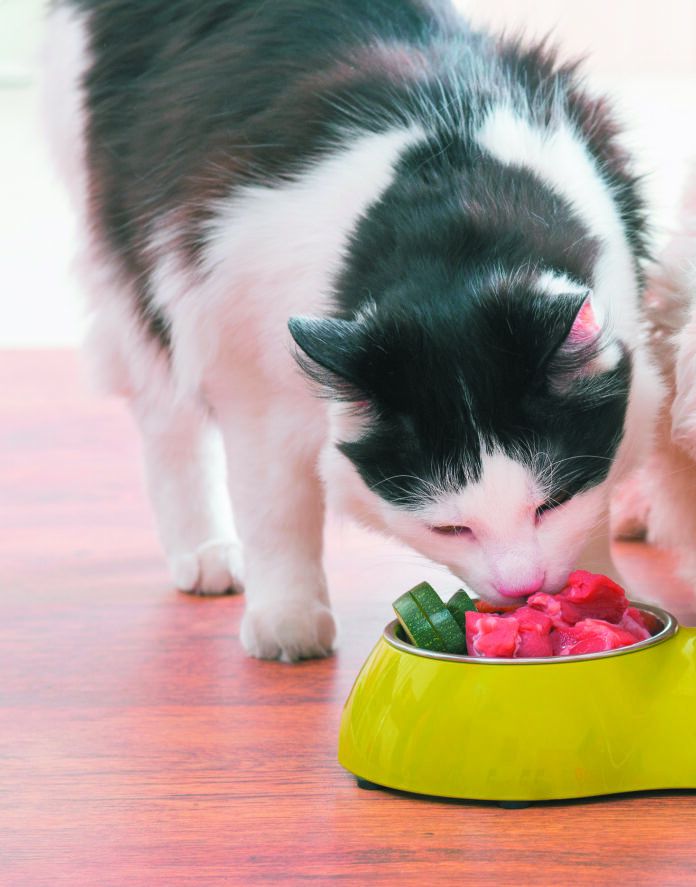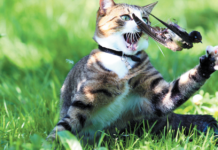Sales of raw pet food have been increasing annually in recent years. In fact, based on surveys conducted in English-speaking countries, it is estimated that more than 50 percent of cats today are fed at least some raw meat, up from just a small fraction in 2008.
The reasons for the shift vary. Some say cats ate rodents raw in the wild so should continue to eat raw food. Others believe raw meat is better digested by cats than meat that is cooked. Still others say that cats who eat raw diets have fewer allergies, better immunity, and fewer parasites. The problem is that the evidence for such claims is generally lacking.
Granted, the ancestors of today’s cats ate their prey raw. But the “wild” life isn’t necessarily one of longevity and good health. A wild animal is successful if it lives long enough to reproduce; we want a lot more from life for our pet cats.
The downsides
What is clear is that raw-meat diets come with an all-too-real risk of bacterial contamination — both to cats and to the people who feed them. It is so clear, in fact, that the Food and Drug Administration, the ASPCA, the Centers for Disease Control and Prevention (CDC), and the American Veterinary Medical Association (AVMA) all note the danger of feeding raw food to pet felines. The CDC says flatfootedly that “raw pet foods can make pets and people sick” and that the “CDC does not recommend feeding raw diets to pets.”
The AVMA even makes the point that a cat can have a subclinical infection with bacteria from raw food. That means the cat doesn’t seem sick, but the harmful bacteria can still be passed on to people. Those particularly vulnerable to infection include the elderly, children, and those with immunocompromised systems.
If the offending bacteria is a particular strain of E. Coli, it could even lead to serious, life-threatening kidney damage. Making the problem more serious still is that dangerous strains of E. Coli have become resistant to one of the more common families of antibiotics used to treat them. It’s not surprising. Bacteria can keep mutating, enabling them to keep a step ahead of antibiotics’ efforts to stop them from multiplying and thereby vanquishing them.
Other bacteria that may be found in raw pet food and can lead to serious illness include Salmonella, Campylobacter, Clostridium, Listeria monocytogenes, and Staphylococcus aureus. In both cats and people, those harmful pathogens can cause vomiting, diarrhea, reduced appetite, and illnesses that attack organs outside the digestive system.
Several years ago, there was even an incident of cats being fed raw pet food — not homemade diets but commercially prepared raw diets purchased in stores — that contained bacteria responsible for tuberculosis. As reported in the Journal of Feline Medicine and Surgery, some cats fed the raw meat became so sick with tuberculosis’s onslaught of fever, decreased appetite, cough, lethargy, increased respiratory rate, weight loss, and enlarged lymph nodes that they had to be euthanized to be put out of their misery. There were no reports of tuberculosis in people, but the disease is zoonotic, meaning it can “jump” from felines to humans.
A false sense of security
Some people feel they can have it both ways by serving their cat raw food that has been freeze dried. But freeze drying does not kill all bacteria. It removes moisture from food with very cold temperatures. The cold temperatures leave some pathogens thriving. And once warmed to room temperature, bacteria can reproduce quickly.
Other methods used to reduce bacteria in commercial raw diets include irradiation and high-pressure pasteurization. Both techniques can make raw diets safer, but they are not utilized by all manufacturers. Even when they are, their efficacy can vary with the technique. Generally speaking, these methods are not known to be as effective at eliminating bacteria as canning, baking, or extruding traditional cat foods.
Adding to the challenge is that many feel it is safe to feed their pets raw food because they adhere to very strict handling procedures. But in one study of close to 200 people who fed raw food to their pets, almost every participant said they felt “very comfortable” that their raw meat preparation practices for their pets were safe, yet six in 10 did not wash their pet’s bowls after feeding. That made the bowls a breeding ground for bacteria that could get into the cat’s next batch of food — and then into the cats, and possibly their human caretakers. Many other risky food safety practices were also reported.
Lest you think the chance of harmful bacteria making it from the bowl to your own system are too low to worry about, consider that such a possibility takes only the slightest deviation from the strictest hygiene practices — not washing your hands long enough with hot, soapy water after feeding your cat raw meat; not thoroughly cleaning your cat’s bowl and the utensil used to scoop out the meat; petting your cat on her coat where the bacteria may have spread when she licked herself; and not thoroughly sanitizing kitchen counters or other surfaces where raw meat was dished out. You can also become contaminated if your cat licks you or licks furniture that you then touch. The bacteria travel that easily.
Bottom line
If scientific research made clear that raw meat is superior to cooked for a cat’s health, people with pets would have a decision to make that weighed the risk/benefit ratio: feed their cats raw meat for their overall health and take a chance on making their pets (and themselves) sick, or feed them less beneficial cooked food and subject them to more marginal health but without bacterial risks. The thing is, the scientific evidence for raw meat’s superior effects on feline health remains scant to nil. While unsupported claims for raw meat’s superiority run rampant on the Internet, reputable scientific research proving an overall health benefit to raw meat for cats remains lacking.
You wouldn’t make a choice to feed a 12-pound baby raw meat, and this is not a choice you need to make for your cat, either. Stick to cooked food for your pet.
© amaviael | Bigstock
A raw meat diet offers a cat little to no upside but lots of downsides.




